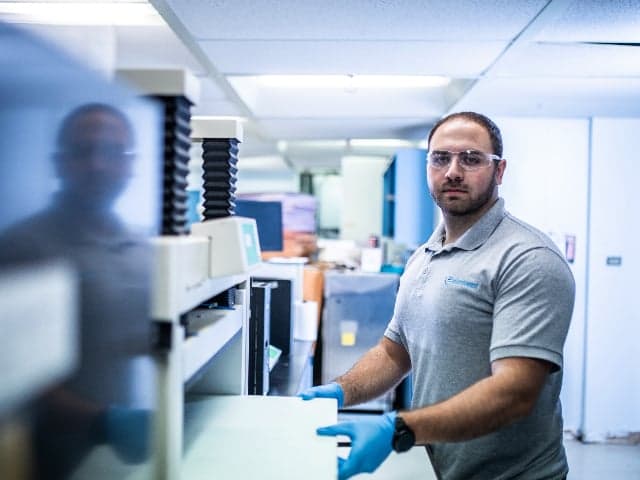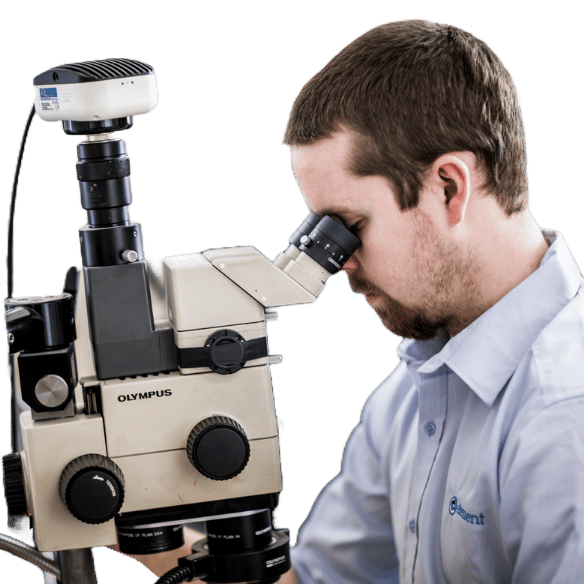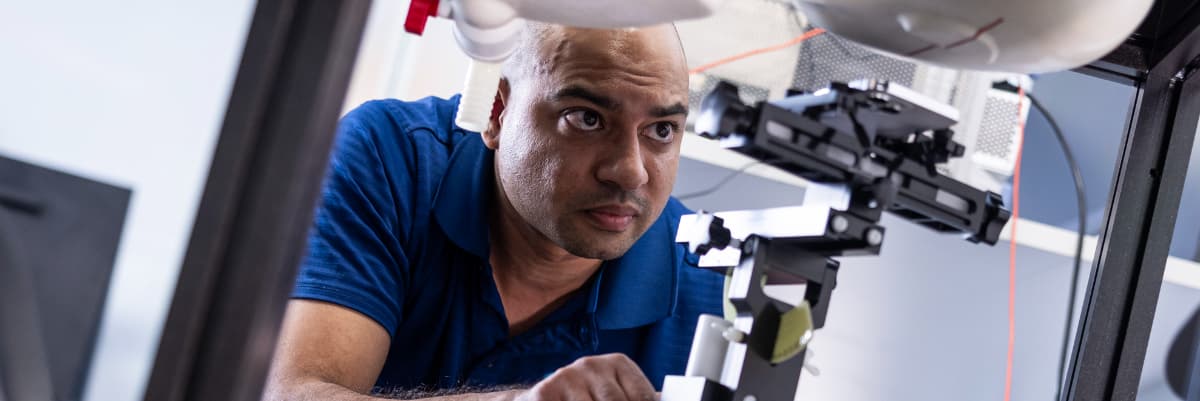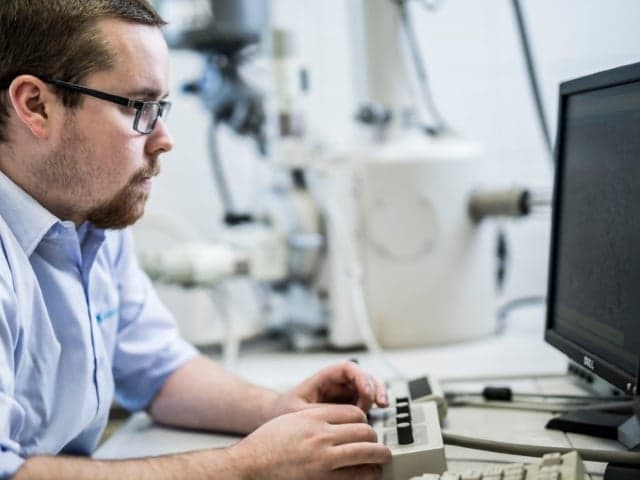Thermal Conductivity Testing Services
Ensure your materials perform optimally under extreme temperature conditions with precise thermal conductivity testing, tailored to you. For Aerospace, Oil & Gas, and Transportation industries, our services deliver the reliable data you need for regulatory compliance and product confidence. Quick turnaround times, non-destructive methods, and expert support help you verify if your materials properly transfer or withstand heat in the most challenging environments.

What are thermal conductivity testing services at Element?
Thermal conductivity is the speed and amount of heat transferred through a material at a given temperature. Accurately measuring this and understanding how materials will react to different heats and situations is essential to be sure your product is fit for purpose in the most extreme conditions, whether the material is insulating, conducting heat, or enduring temperature fluctuations.
Industries including Aerospace, Oil & Gas and Transportation use thermal conductivity testing to assess changes in thermal properties over time, temperature variations and fluid absorption.
Element’s comprehensive thermal conductivity testing help you determine effective materials and compatible operating methods for specific temperatures.

What can Element offer you for thermal conductivity testing?
Components and materials we test
Components and materials we test
We test a wide range of materials across multiple industries to determine thermal conductivity properties. Our testing capabilities include:
- Aerospace components and materials
- Oil and gas infrastructure materials
- Transportation industry components
- Insulation materials
- Materials with varying conductivity (from low to high)
- Composite structures
- Materials that need to withstand temperature fluctuations
- Products requiring R-value certification
Methods and solutions offered
Methods and solutions offered
Our comprehensive range of thermal testing methods ensures accurate and reliable results.
- Laser Flash Diffusivity (LFD): Compliant with ASTM E1461 standards for precise thermal diffusivity measurements
- Axial Flow: Evaluates thermal conductivity via axial heat flow
- Absolute Axial Heat Flow: For measuring materials with low to high conductivity across different conditions
- Comparative Cut Bar: Enables comparative analysis of thermal conductivity between different materials or samples
Non-Destructive Test Methods
Testing materials to ensure they can withstand harsh environments and conditions without causing damage is a delicate balance. Methods like Laser Flash Diffusivity and Axial Flow are non-destructive, meaning they provide valuable information about a material's thermal properties without causing significant damage. This allows for rigorous testing without compromising the integrity of the material.
Key tests offered
Key tests offered
We provide comprehensive solutions tailored to your specific thermal conductivity testing needs. In addition to the thermal conductivity testing methods listed above, our testing offering includes:
- Analysis of your material type, expected conductivity, and desired test temperature range – we test from -10°C to 190°C) to simulate real-world conditions
- R-value measurement and testing
- Fluid absorption testing to evaluate performance changes
Cutting-edge equipment we use
Cutting-edge equipment we use
- The Probe: Utilizes advanced probing techniques to analyze thermal conductivity properties across various materials and environments.
- Naztech heat flow meter (HFM): Used to characterize material thermal conductivity and “R”-value. The HFM creates a thermal gradient across a sample, measuring the amount of heat flowing in and out of the material. The Fourier equation is then used to calculate the thermal conductivity of the sample.
Which labs offer this service
Which labs offer this service
Our team operates from energy hubs across the world, providing global access to our expert capabilities. Find out where your nearest energy hub is on our Locations Page.
Customized, Accessible Technical Support
Customized, Accessible Technical Support
You may require assistance in understanding and interpreting test results or optimizing materials for specific thermal conductivity requirements. Our technical experts provide crucial support to address your needs and concerns effectively. Element offers custom testing programs tailored to your unique requirements and specifications. Whether it's unconventional test conditions or specific material properties, we work closely with clients to develop customized testing solutions that address their individual needs effectively.
Standards we meet and the materials we test
We conduct rigorous thermal conductivity testing according to internationally recognized standards, including:
- ASTM C518
- ISO 8301
- ASTM E1461
These standards ensure your products meet industry-specific regulatory requirements and provide documentation demonstrating compliance.
Your Challenges, Our Solutions
Risk of Equipment Failure
Technical Complexity
Testing Reliability Concerns
Time Pressure
Why Choose Element

Unmatched Precision Data
Ensure Regulatory Compliance
Safeguard and Minimize Risk
Custom Testing Solutions
Frequently asked questions
How do you ensure accuracy and reliability in thermal conductivity testing and measurement?
Customers often face concerns regarding the accuracy and reliability of thermal conductivity testing results, which are crucial for making informed decisions about their materials or products. Element tackles this by employing rigorous testing methodologies and quality control measures to ensure the highest level of accuracy and reliability in our testing processes. Our state-of-the-art equipment and experienced technicians adhere to industry best practices and standards, guaranteeing precise and consistent results. Additionally, we regularly undergo accreditation and proficiency testing to uphold the quality and reliability of our testing services. With Element, you can have assurance in the accuracy of our thermal conductivity measurements, enabling you to make confident decisions.
What is the relationship between R-value and thermal conductivity?
R-value testing considers both thermal conductivity and the material's thickness to assess its insulating properties. While thermal conductivity testing focuses solely on a material's ability to conduct heat.
What type of samples are recommended for Thermal Conductivity testing?
We recommend homogeneous, 12” x 12” samples with 0.5” to 4” thickness. Inhomogeneous materials can produce inconsistent thermal conductivity and are not advised.

Explore our global network of labs and find your nearest location
VIEW ALL LOCATIONSRelated services

Oil and Gas Testing
Element offers a wide range of Oil & Gas testing services, including mechanical and NDT testing, structural and corrosion testing, and failure analysis. Learn more.

Thermal Analysis Services
Element's thermal analysis services help identify material properties, anticipate changes, and reduce failure risks. Our experts provide accurate, reliable testing for polymers, composites, and advanced materials.

Scanning Electron Microscopy (SEM) with EDX Analysis
Scanning Electron Microscopy (SEM) and EDX analysis provide high-resolution imaging and elemental composition insights to detect surface defects, contaminants, and material properties, supporting manufacturers with detailed material evaluations.
